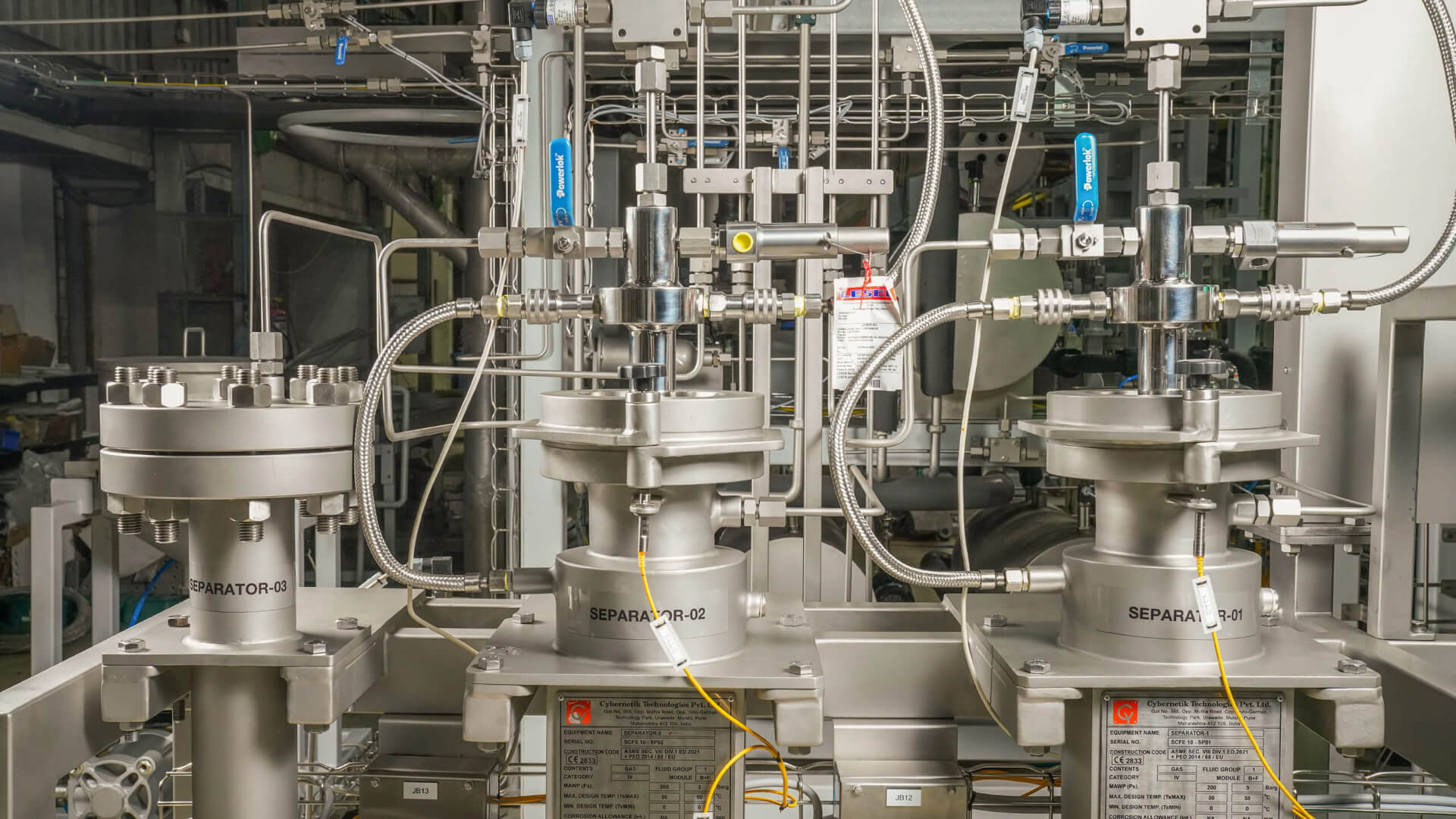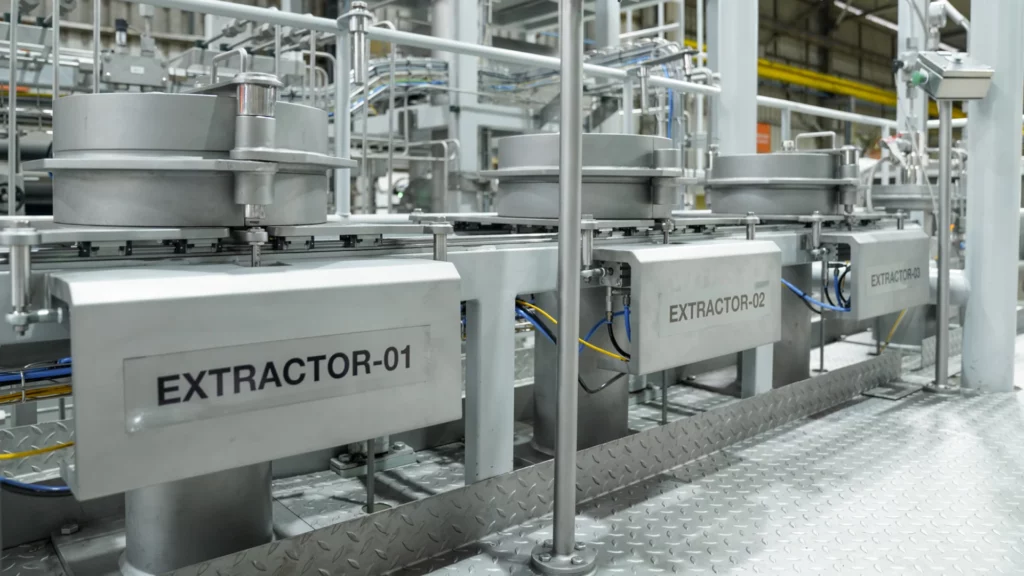Supercritical CO₂ extraction has become a cornerstone for producing high-purity extracts in industries like pharmaceuticals, nutraceuticals, and botanicals, leveraging carbon dioxide’s unique properties above its critical point of 31.1°C and 73.9 bar. In this state, CO₂ acts as a tunable solvent, combining liquid-like solvency with gas-like diffusivity to extract compounds such as cannabinoids, terpenes, and essential oils from organic materials. The Level 2 supercritical CO₂ extractor from Buffalo Extraction Systems, featuring 25-liter vessels in a 2 or 3-unit configuration, excels in mid-scale operations with a closed loop CO₂ extractor design that recycles food-grade CO₂ for sustainability. A standout feature of these systems is the co-solvent pump, which significantly expands the range of extractable compounds by modifying the solvent’s polarity and density. For operators of a co2 extraction machine, this pump transforms versatility, enabling access to polar and semi-polar compounds that pure CO₂ struggles to capture, thus broadening the scope of a co2 extraction system.
Integrated with proprietary features like the SCADA Systems for recipe-based control and Series Extractor mode for sequential processing, the co-solvent pump enhances the functionality of supercritical CO₂ extraction equipment. For those evaluating a co2 extraction machine for sale, the pump’s ability to diversify outputs without additional hardware makes it a critical factor in justifying the supercritical CO₂ extraction machine price. Below, we explore its mechanics and pivotal role in expanding compound extraction, drawing insights from Buffalo Extraction Systems’ specifications.
Understanding Supercritical CO₂ Extraction and Its Limitations
The Level 2 co2 extractor operates in batch mode, processing milled, pelletized, or granulated biomass in vessels rated for 350-650 bar (5000-9500 PSI) and temperatures of 70-110°C (158-230°F). A high-pressure pump (150-350 LPH flow rate) compresses CO₂ to its supercritical state, where it permeates the biomass to dissolve lipophilic compounds. The solvent-laden stream then enters dual separators with independently controlled pressures, fractionating extracts—e.g., terpenes in one, heavier oils in another. The CO₂, stripped of extracts, vents as gas, condenses, and recycles via the CO₂ Feeding & Recovery System, ensuring minimal waste in this closed loop CO₂ extractor.
Pure supercritical CO₂ excels at extracting non-polar compounds like hydrocarbons but is less effective for polar molecules such as flavonoids, alkaloids, or phenolics due to its low dielectric constant. This selectivity limits full-spectrum extraction, especially for botanicals with diverse chemistries. The co-solvent pump addresses this by injecting modifiers like ethanol or propane into the CO₂ stream, altering its solvating properties. As noted on Buffalo’s site, supercritical CO₂ “exhibits solvating properties of a liquid and the diffusivity of a gas,” and the pump enhances this by enabling hybrid solvent behavior, making it a powerful medium for broader extraction in a c02 extraction machine.
The Co-Solvent Pump’s Role in Expanding Extraction Capabilities
The co-solvent pump, a standard feature in Level 2 systems, is a precision metering device that introduces small volumes of co-solvents (e.g., ethanol for polarity, propane for density) into the supercritical CO₂ stream before it enters the extraction vessels. Seamlessly integrated with automatic changeover valves and the SCADA Systems, it allows operators to fine-tune extraction parameters for diverse compounds. Here’s how it revolutionizes compound extraction in supercritical fluid extraction equipment:
1. Broadening Polarity Range for Comprehensive Extraction
The primary limitation of pure CO₂ is its non-polar nature, which struggles to solubilize polar or semi-polar compounds critical for full-spectrum extracts. The co-solvent pump counters this by injecting modifiers like ethanol, which increases the solvent’s polarity through hydrogen bonding. This enables a co2 extraction machine to target polar actives—e.g., flavonoids in hemp or glycosides in herbs—that would otherwise remain in the biomass. Propane, alternatively, adjusts solvent density, enhancing extraction of mid-polarity compounds like certain terpenoids.
Operationally, the pump delivers co-solvent at controlled ratios, synchronized via the system’s PLC and visualized on the SCADA Systems intuitive interface. Operators can program recipes to toggle co-solvent use—e.g., pure CO₂ for initial non-polar fractions, then ethanol-enhanced for polar targets—within a single batch. In Series mode, sequential vessels can alternate solvent profiles, extracting non-polar oils in one vessel and polar compounds in the next without cross-contamination. This versatility yields richer extracts, ideal for applications like CBD-infused edibles or antioxidant-rich botanical oils, expanding the marketability of outputs from a co2 extract machine.
2. Optimized Fractionation Through Density and Selectivity Control
The co-solvent pump enhances the solvent’s density and selectivity, allowing precise targeting of compounds with varying molecular weights. Propane, for instance, increases fluid density at lower pressures, reducing energy demands while solubilizing heavier or temperature-sensitive molecules. Ethanol, conversely, sharpens selectivity for polar fractions, improving separation efficiency in the dual separators. Buffalo’s site emphasizes “precise pressure control that guarantees consistent solvent solubility,” and the pump amplifies this by dynamically adjusting the solvent’s properties mid-run.
In practice, this means cleaner fractionation: non-polar waxes separate early, while polar actives concentrate in later fractions, collected effortlessly via the system’s special separator design for resinous or low-viscosity products. The pump’s integration ensures homogeneous mixing, avoiding phase separation that could clog high-pressure components. For a supercritical CO₂ extraction machine, this translates to higher-purity extracts with less post-processing, crucial for GMP-compliant industries like pharmaceuticals.
3. Efficiency and Sustainability Enhancements
By expanding extraction capabilities, the co-solvent pump streamlines workflows, reducing reliance on secondary methods like ethanol soxhlet or hydrocarbon extraction. This consolidation saves time and resources in a co2 extraction system, as operators handle diverse compounds in one machine. The closed-loop design recycles both CO₂ and co-solvents efficiently, with minimal carryover due to precise separator controls. Buffalo’s site highlights “reusability of CO2” and “non-toxic” operations, and the pump aligns with these by using food-grade modifiers in trace amounts, maintaining safety and sustainability.
Energy efficiency improves as co-solvents lower the pressure needed for certain extractions, easing strain on the high-pressure pump and heater. The SCADA Systems predictive maintenance tracks pump performance, flagging issues like seal wear or flow inconsistencies, ensuring uptime. For a supercritical CO₂ extraction machine price in the mid-six-figure range, these savings accelerate ROI by diversifying outputs without additional CAPEX. The system’s non-flammable, anti-hydrolysis properties further protect delicate actives, enhancing stability for formulations like cosmeceuticals.

4. Operator Empowerment and Scalability
The co-solvent pump’s impact is magnified by Level 2’s user-centric design. The SCADA System enables recipe-based control, allowing operators to program co-solvent injections via drag-and-drop interfaces—e.g., ramping ethanol for polar spikes mid-batch. Real-time dashboards monitor injection rates and extract profiles, with remote alerts for anomalies, empowering agile adjustments. The system’s “intuitive intelligence” cuts training time, making advanced extractions accessible to diverse teams.
Scalability shines: a co2 extract machine with co-solvent capabilities transitions seamlessly from R&D to production, handling varied feedstocks like cannabis, spices, or medicinal herbs. In Series mode, the pump supports sequential extractions across vessels, maximizing throughput. For niche markets—e.g., polar-enriched extracts for beverages—this flexibility commands premium pricing.
Broader Impact and Strategic Value
The co-solvent pump positions Level 2 systems as versatile platforms in supercritical CO₂ extraction equipment, bridging the gap between CO₂’s green credentials and the broad solvency of organic solvents. It fosters innovation by enabling custom extracts, from polar-heavy nutraceuticals to hybrid botanical blends, without compromising safety or compliance (CE, ASME, PED, GMP certifications). As sustainability and regulatory pressures intensify, the pump’s resource efficiency—minimal raw material damage, reusable solvents—sets a benchmark.
For those researching a co2 extraction machine for sale, the pump’s inclusion is a strategic edge, enhancing a system’s value proposition at any supercritical CO₂ extraction machine price point. It’s not just about extracting more compounds; it’s about extracting smarter, unlocking a wider chemical palette with precision and efficiency.




